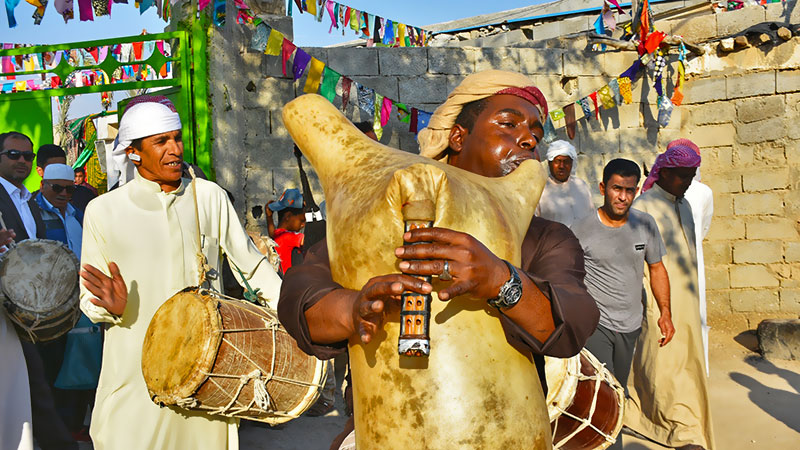 Signin with Google
Signin with Google Signin with Facebook
Signin with Facebook Culture
CultureThe Melody of Legends Speaks out in Ney Anban

Ney Anban in Persian, worldly known as bagpipe is an instrument which can be played wherever one needs to express and share their joy or sorrow with others like in weddings and special rituals. The Iranian bagpipe is deeply rooted in the culture and traditions of southern regions of Iran including Khuzestan, Hormozgan and Bushehr province which is considered as the hometown of this instrument, while Kerman Province has got great Ney Anban musicians often less discovered by the public.
The origins of Ney Anban
When it comes to bagpipes, many think it is originally an Irish musical instrument and is native to Ireland. However, there are many doubts about the exact birthdate of this instrument. Almost all experts agree on the fact that bagpipe was first found in the Middle East, and the upper Persian Gulf regions (south of Iran). According to Dr Peter Frankopan (director of the Centre for Byzantine Research at Oxford), the bagpipe is traditionally linked to Persia. It is distinguished considering Persia’s long dateable legacy linked with music from the shepherding world. And from Persia, Ney anban spread through the world, reached Europe to the west and even China in the east.

Moreover, an illustration of a bagpiper was found in the carvings of Taq-e-Bostan archaeological site (Kermanshah Province, Iran) which dates back to the Sassanid era from 224 to 651 AD. Other historical documents show Ney Anban’s antiquity in Iranian musical history, including two pieces of exquisite illuminated manuscripts displayed in Victor & Albert Museum in London, painted by Reza Abbasi, the great Persian miniature master in the Safavid Era that depicts detailed images of bagpipers playing the instrument.
The organic sound of the cattle
There are nearly 130 types of bagpipes all around the world mostly made of organic materials with common and different features in terms of sound and shape. The Iranian bagpipe is a drone less, double chanter instrument made of two main parts, the bag and the pipe. The bag is responsible for keeping the air which is sometimes designed with distinctive traditional patterns among modern players. The second part of Ney Anban is the blowpipe which is traditionally made of wood; this instrument also has two chanters that are made of wood as well. The blowpipe is named Ghamish or Pikak in the west of Hormozgan.
An inseparable part of southern traditions
As formerly mentioned, Ney Anban is an instrument native to Bushehr, Khuzestan and west of Hormozgan Province, in Southern Iran. This instrument holds a vital place in the cultural and traditional rituals of the people of this region. It is played at weddings and celebrations since it can produce both joyful and sad tunes.

Moreover, Bushehr is famous for its rich, unique mixture of Persian, Arab and African music. It has some specific characteristics like the singing of local couplets, mostly romantic poems in the form of Avaz, called Sharwa. or another type called Yazleh in which the melody is more important than the lyrics and is performed by a group of singers. Both Sharwa and Yazleh are accompanied by playing the Ney Anban.
Furthermore, the sound of Ney Anban is considered as the music of work. Fishing is one of the major occupations in the south of Iran and Ney Anban is the instrument that accompanies fishermen to cheer them up while sailing on the sea.
Iran's national heritage
International bagpipe day is celebrated on 10 March 2012 after an idea by the Bagpipe Society. In Iran, Ney Anban was registered as a national heritage in 2015 by Mohsen Sharifian. He is one of the pioneer masters of Ney Anban from Bushehr that had a significant role in introducing it to the world as a traditional Iranian musical instrument. He has published a book about Ney Anban as well as several music albums and held many concerts all around the globe playing Ney Anban and performing pure Bushehri folk music.
As discussed above, Ney Anban is an inseparable part of Southern Iran’s culture where music plays a significant role in all aspects of life. The presence of this instrument in traditional rituals is considered vital.
The legacy of Afro-Iranians
Between the west of Hormozgan and Bushehr, in a remote village named Machahil, live the last ancestors of migrating African musicians of Ney anban whose style is known as Moqami or blacks. There are family groups that made the most intact folkloric music bands in the rural areas play the Ney Anban in a very ancient and traditional style. Moqami players play Ney Anban barefoot with special movements as a tradition since they believe the playground of this instrument is sacred.

Melodies of these Afro-Iranians have been transferred from generation to generation as if they have tasted grieves one to another, to tell the extract of their myths that once happened and were forgotten in the corridors of history. The performance of Hormozgan and Bushehr's Afro groups preserved from any change or modernity; has the trace of hundreds of years on it and bewitches spectators.10 March is Bagpipe International Day.
By Nazanin Moayed / TasteIran



